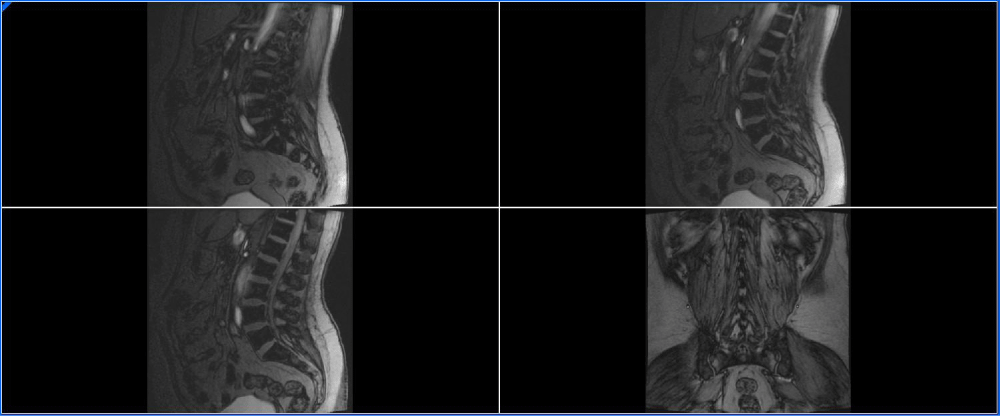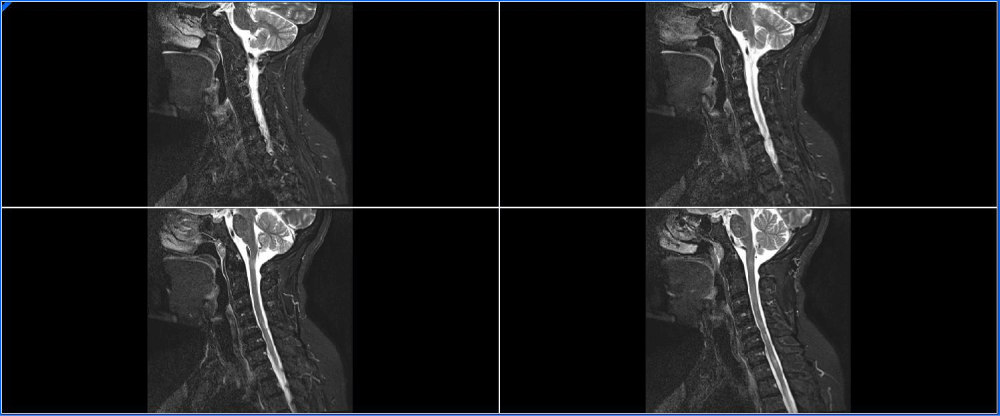Global Journal of Medical and Clinical Case Reports
The Heart That Wasn’t Attacked: A Case of Transverse Myelitis
Mark M Mokhtar1*, Ahmed Ibrahim2 and Catherine E Lempke1
2Northwest Hospital, Seattle, Washington, USA
Cite this as
Mokhtar MM, Ibrahim A, Lempke CE (2018) The Heart That Wasn’t Attacked: A Case of Transverse Myelitis. Glob J Medical Clin Case Rep 5(1): 007-009 DOI: 10.17352/2455-5282.000059Background
Transverse myelitis is an autoimmune demyelination disease of the spinal cord that can present with a myriad of symptoms ranging from altered sensations, weakness, loss of bowel control and so forth. There are approximately 1400 new cases reported each year in the United States, but this is likely an underestimation, without a gender bias or familial predisposition and a bimodal age distribution of onset (between 10-19 and 30-39) [1]. The majority of cases are idiopathic and so post-infectious is cited as the reason, although there are secondary causes such as being on the spectrum of multiple sclerosis, neurosarcoidosis, paraneoplastic syndromes and many others. This disease has a 5-10% chance of progressing to other demyelinating diseases, such as multiple sclerosis [2].
Case Presentation
A 62 year old African American female presented to her primary care physician for a chest pain that radiated to her right shoulder that lasted for an hour and then self-resolved. The primary care did the proper follow up and found no reason to suspect diagnosed her with muscle spasm. Two weeks following, she complains that she has an altered sensation on the right side of her body when showering, and that she was now beginning to drag her right foot without being aware of it. She denies blurred vision, fever, chills, chest pain, shortness of breath, confusion, weakness, headaches, urinary/bowel problems, neck or back pain, nausea and vomiting.
Past medical history
The patient’s past medical history is significant for: hypertension, hyperlipidemia, and hypothyroidism.
Family history
GENERAL: alert and oriented, no acute distress. VITAL SIGNS: the blood pressure (174/93) everything else was unremarkable, EYE: pupils are equal, round and reactive to light. HENT: normocephalic, oral mucosa is moist no asymmetry. RESPIRAOTRY: lungs clear to auscultation, respirations are non-labored, breathe sounds are equal, symmetrical chest wall expansions. CARDIOVASCULAR: Normal rate and rhythm, no murmurs, good pulses that are equal in all extremities. No edema, dorsal pedalas 2+ bilaterally. GASTROINTESTINAL: soft, non-tender, non-distended, with normal bowel sounds. MUSCULOSKELETAL: normal range of motion, no swelling, negative Homan’s sign. NEUROLOGICAL: alerted and oriented, 5/5 bilateral upper extremities, 5/5 left lower extremity, 3/5 right lower extremity, with decreased sensation in right leg, and loss of proprioception in the right lower limb. Speech is clear and coherent. PSYCHIATRIC: cooperative, appropriate mood and affect, with normal judgment.
Laboratory data and imaging
Urine analysis was grossly negative, no nitrates, leukocyte esterase, or RBCs, and CBC was significant for increased BUN (21 mg/dL) with increased neutrophil count (75.1%), but otherwise unremarkable. CT of the head/brain, x-ray of right hip, knee and ankle, Doppler, and MRI of head/brain and lumbar areas were negative (Figure 1). The MRI of the cervical spine however, showed signs of demyelination (Figure 2).
Hospital course
The patient presented to the emergency department with two weeks of right leg weakness and decreased sensation on the right side of her body. From the history, CVA was suspected and proper work up was followed including a CT of the head and brain without contrast, an ultrasound Doppler, lipid panel, HBA1c check and MRI of the brain and MRA of the arteries. All of which lead to no results, which required a consult from neurology.
Further neurological testing revealed loss of proprioception in the right lower extremity, as well as 3/5 weakness, there was also noted a very slight decrease in strength in the upper extremity, noted as a 4+/5. The patient began her course of steroids shortly thereafter and promptly discharged as her strength returned to her.
Discussion
We present the case of a 62 year old female who present to her primary care physician with complaints of chest pain that radiated to her shoulder two weeks before presenting to the emergency department. At that time a full work up for cardiovascular was done and was shown to be grossly normal. Approximately two weeks after she complained of being unable to properly walk and lift her leg and complained of altered sensation on the entire right side of her body. She was later diagnosed with transverse myelitis (TM), and subsequently treated with high doses of corticosteroids and made a full recovery.
A likely cause of this patient’s condition can be traced to an upper respiratory infection, of which the patient admits having a month or two prior to the events. The majority of cases are idiopathic in nature, but some evidence suggests that TM may be disease associated [3]. It is also important to note that, although TM shares many similarities to other demyelination diseases, this is in fact a mixed inflammatory disorder that can affect the myelin sheaths, olidogendrocytes, axons and even neurons, due to a perivascular infiltration of monocytes and lymphocytes [4].
A likely cause of this patient’s condition can be traced to an upper respiratory infection, of which the patient admits having a month or two prior to the events. The majority of cases are idiopathic in nature, but some evidence suggests that TM may be disease associated [3]. It is also important to note that, although TM shares many similarities to other demyelination diseases, this is in fact a mixed inflammatory disorder that can affect the myelin sheaths, olidogendrocytes, axons and even neurons, due to a perivascular infiltration of monocytes and lymphocytes [4].
Conclusion
Transverse myelitis often presents with motor, sensory and autonomic dysfunction or any combination of the three. Motor dysfunctions are nonspecific, either flaccid or spastic paralysis or alternations between the two, as are the sensory presentations, dysethesia, parastehsia or pain [3]. These symptoms are often mistaken for a transichemic attack, especially given the similar presentations of symptoms and their ability to resolve. The management of transverse myelitis is to first start an aggressive therapy of high dose glucocorticoids, to limit the body’s autoimmune attack, followed by close observation for any recurrent symptoms [7]. In refractory cases or cases where glucocorticoids have failed, plasma exchange has shown some positive results in some studies, leading some clinicians to treat with both steroids and plasma exchange [8]. Other promising treatments include intravenous cyclophosphamide; which yielded positive results [9], azathioprine, methotrexate, and mycophenolate for the recurrent disease outbreak [3].
The prognosis of TM varies greatly among the cases reported. With proper rehabilitation and medical therapy, many patients get at least partial recovery within the first few months [10]. However, many patients may have persistent symptoms and may even worsen in severity, and is associated with a worse prognosis overall [11]. The reoccurrence rate for idiopathic patients is roughly 25-30%, while the disease-associated rate is as high as 70% [12]. In presenting this patient we bring attention a rare case of transverse myelitis and its unusual presentation. Further work up is required for a biomarker.
- Krishnan C, Greenberg B (2016) Transverse myelitis. Link: https://goo.gl/E1mGgS
- Chen L, Li J, Guo Z, Liao S, Jiang L (2013) Prognostic indicators of acute transverse myelitis in 39 children. Pediatr Neurol 49: 397-400. Link: https://goo.gl/oGskdU
- Kaplin AI, Krishnan C, Deshpande DM, Pardo CA, Kerr DA (2005) Diagnosis and management of acute myelopathies. Neurologist 11: 2-18. Link: https://goo.gl/ok76Nd
- Krishnan C, Kaplin AI, Pardo CA, Kerr DA, Keswani SC (2006) Demyelinating Disorders: update on transverse myelitis. Curr Neurol Neurosci Rep 6: 236-243. Link: https://goo.gl/jEgS2a
- Jeffery DR, Mandler RN, Davis LE (1993) Transverse myelitis. Retrospective analysis of 33 cases, with differentiation of cases associated with multiple sclerosis and parainfectious events. Arch Neurol 50: 532-535. Link: https://goo.gl/CpQVfQ
- Christensen PB, Wermuth L, Hinge HH, Bømers K (1990) Clinical course and long-term prognosis of acute transverse myelopathy. Acta Neurol Scand 81: 431-435. Link: https://goo.gl/xy4T4Q
- Scott TF, Frohman EM, De Seze J, Gronseth GS, Weinshenker BG (2011) Evidence-based guideline: clinical evaluation and treatment of transverse myelitis: report of the Therapeutics and Technology Assessment Subcommittee of the American Academy of Neurology. Neurology 77: 2128-2134. Link: https://goo.gl/r1vrwN
- Weinshenker BG, O'Brien PC, Petterson TM, Noseworthy JH, Lucchinetti CF, et al. (1999) A randomized trial of plasma exchange in acute central nervous system inflammatory demyelinating disease. Ann Neurol 46: 878-886. Link: https://goo.gl/EqQoYd
- Greenberg BM, Thomas KP, Krishnan C, Kaplin AI, Calabresi PA, et al. (2007) Idiopathic transverse myelitis: corticosteroids, plasma exchange, or cyclophosphamide. Neurology 68: 1614-1617. Link: https://goo.gl/7BHUw9
- Defresne P, Hollenberg H, Husson B, Tabarki B, Landrieu P, et al. (2003) Acute transverse myelitis in children: clinical course and prognostic factors. J Child Neurol 18: 401-406. Link: https://goo.gl/5cMvgy
- Bruna J, Martínez-Yélamos S, Martínez-Yélamos A, Rubio F, Arbizu T (2006) Idiopathic acute transverse myelitis: a clinical study and prognostic markers in 45 cases. Mult Scler 12: 169-173. Link: https://goo.gl/RRP7a1
- Berman M, Feldman S, Alter M, Zilber N, Kahana E (1981) Acute transverse myelitis: incidence and etiologic considerations. Neurology 31: 966-971. Link: https://goo.gl/Hu9Yh6

Article Alerts
Subscribe to our articles alerts and stay tuned.
 This work is licensed under a Creative Commons Attribution 4.0 International License.
This work is licensed under a Creative Commons Attribution 4.0 International License.


 Save to Mendeley
Save to Mendeley
